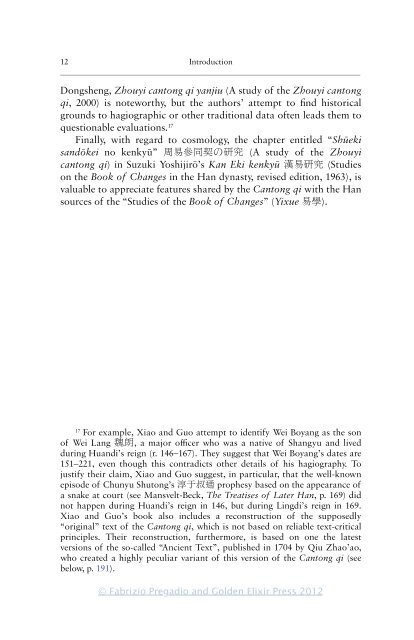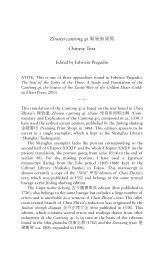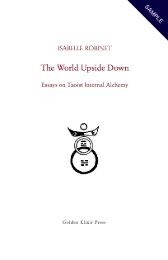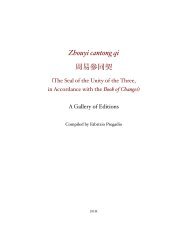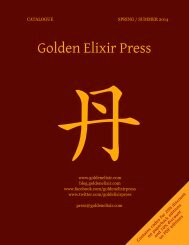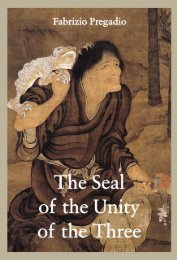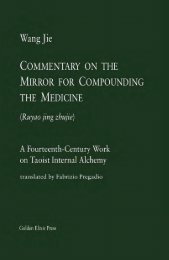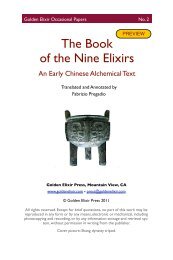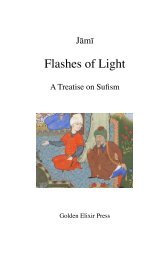The Seal of the Unity of the Three â Vol. 2 - The Golden Elixir
The Seal of the Unity of the Three â Vol. 2 - The Golden Elixir
The Seal of the Unity of the Three â Vol. 2 - The Golden Elixir
- No tags were found...
Create successful ePaper yourself
Turn your PDF publications into a flip-book with our unique Google optimized e-Paper software.
12 Introduction<br />
—————————————————————————————————————————<br />
Dongsheng, Zhouyi cantong qi yanjiu (A study <strong>of</strong> <strong>the</strong> Zhouyi cantong<br />
qi, 2000) is noteworthy, but <strong>the</strong> authors’ attempt to find historical<br />
grounds to hagiographic or o<strong>the</strong>r traditional data <strong>of</strong>ten leads <strong>the</strong>m to<br />
questionable evaluations. 17<br />
Finally, with regard to cosmology, <strong>the</strong> chapter entitled “Shūeki<br />
sandōkei no kenkyū” 周 易 參 同 契 の 研 究 (A study <strong>of</strong> <strong>the</strong> Zhouyi<br />
cantong qi) in Suzuki Yoshijirō’s Kan Eki kenkyū 漢 易 研 究 (Studies<br />
on <strong>the</strong> Book <strong>of</strong> Changes in <strong>the</strong> Han dynasty, revised edition, 1963), is<br />
valuable to appreciate features shared by <strong>the</strong> Cantong qi with <strong>the</strong> Han<br />
sources <strong>of</strong> <strong>the</strong> “Studies <strong>of</strong> <strong>the</strong> Book <strong>of</strong> Changes” (Yixue 易 學 ).<br />
17<br />
For example, Xiao and Guo attempt to identify Wei Boyang as <strong>the</strong> son<br />
<strong>of</strong> Wei Lang 魏 朗 , a major <strong>of</strong>ficer who was a native <strong>of</strong> Shangyu and lived<br />
during Huandi’s reign (r. 146–167). <strong>The</strong>y suggest that Wei Boyang’s dates are<br />
151–221, even though this contradicts o<strong>the</strong>r details <strong>of</strong> his hagiography. To<br />
justify <strong>the</strong>ir claim, Xiao and Guo suggest, in particular, that <strong>the</strong> well-known<br />
episode <strong>of</strong> Chunyu Shutong’s 淳 于 叔 通 prophesy based on <strong>the</strong> appearance <strong>of</strong><br />
a snake at court (see Mansvelt-Beck, <strong>The</strong> Treatises <strong>of</strong> Later Han, p. 169) did<br />
not happen during Huandi’s reign in 146, but during Lingdi’s reign in 169.<br />
Xiao and Guo’s book also includes a reconstruction <strong>of</strong> <strong>the</strong> supposedly<br />
“original” text <strong>of</strong> <strong>the</strong> Cantong qi, which is not based on reliable text-critical<br />
principles. <strong>The</strong>ir reconstruction, fur<strong>the</strong>rmore, is based on one <strong>the</strong> latest<br />
versions <strong>of</strong> <strong>the</strong> so-called “Ancient Text”, published in 1704 by Qiu Zhao’ao,<br />
who created a highly peculiar variant <strong>of</strong> this version <strong>of</strong> <strong>the</strong> Cantong qi (see<br />
below, p. 191).<br />
© Fabrizio Pregadio and <strong>Golden</strong> <strong>Elixir</strong> Press 2012


